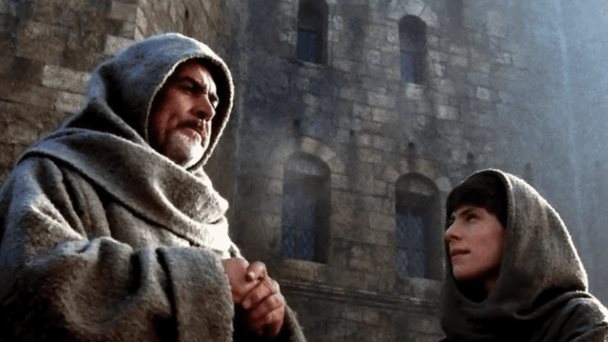Sean Connery and Christian Slater in ‘The Name of the Rose’.
The last week of the last Madrid Book Fair, already in June, a question began to circulate among readers walking through El Retiro: who was Lorenzo G. Acebedo, the mysterious author of La tavern de Silos? Signed with a pseudonym, the novel, starring Gonzalo de Berceo, was the ideal mix between the noir and historical genres and, by virtue of anachronistic but effective word of mouth, copies flew from the Tusquets publishing house’s booth. Months later, the mystery of authorship remains unsolved, but the success of this story of books, murders and wine in the 13th century proves the vitality of a hybrid that has become the publishing world’s latest bet for the most popular genre. among readers. It is worth clarifying something before continuing. Not every crime novel set in the past is a historical thriller (for example, Quirke’s superb stories written by Benjamin Black and set in Ireland in the 1950s are not) nor is every historical crime novel, such as the Hilary saga. Mantel on Henry VIII, can be classified into this hybrid.
It is impossible to talk about crime novel historical without referring to The Name of the Rose by Umberto Eco, but there are also Philip Kerr with his Bernie Gunther series (a Philip Marlowe in Nazi Germany) or the thirty novels by Anne Perry starring Thomas and Charlotte Pitt. Why then this resurgence? Where is the key to success? “This genre, so difficult to write, provides the reader with the possibility of sharpening their wit and learning about an era. And they are stories with a very high level of sophistication,” explains María Fasce, editor of Alfaguara Negra, a label that has paid special attention to this trend.
There is also the editorial hunger, the desire to impose one fashion over another (Nordic, domestic, country, cozy, enigma, etc.), to take advantage of the dynamism and breadth of the genre.
A regular at this hybrid thanks, above all, to the series by Víctor Ros, is Jerónimo Tristant, who has just won the VI National Police Novel Award with Pamfleten (Algaida). The novel tells of the hunt for a murderer of women in Flanders in 1576, under the rule of the Tercios. If we talk about awards, part of the current momentum is due to another, the Planeta, which in 2021 won La bestia, by Carmen Mola.
Aside from the noise surrounding authorship (it was then discovered who the three writers behind the pseudonym were), there remains a novel with the ingredients that work in this mixture. The trio came to the genre, however, in a curious way. “The pandemic caught us: we were locked up at home and we didn’t know how we were going to get out, or even if we were going to get out. We were writing what later became The Mothers [cuarta entrega de la serie iniciada por La novia gitana] and we had a problem: it was going to be old before it came out.
That’s why we chose to get into the historical thriller,” says Jorge Díaz, one of the three members of the group. Now they have returned with Hell (Planet), crime novel, historical in slave-owning Cuba and serial, all in one. “Both camps have to work: the thriller part, the crimes, trying to find out who the murderer is, and then the historical part. If you miss one, the novel is lame,” analyzes Díaz.
The Molas were traveling a path that has had great exponents in recent years such as the Frenchman Hervé Le Corre (Under the Flames or After the War, both in Reservoir Books, considered to be two of the best historical thrillers of the decade) or Niklas Natt och Dag with his powerful criminal trilogy in Sweden at the end of the 18th century, beginning with the dazzling 1793 (Salamandra). There is no era that escapes review and so we have, for example, the violent and epic The Right of Wolves (Alfaguara Negra) by Stefano De Bellis and Edgardo Fiorillo, set in Cicero’s Rome. Without forgetting the fertile field of the Nazi era, especially with Jean-Christophe Grangé and Death in the Third Reich (Destiny) and Fabiano Massimi, author of works such as The Angel of Munich (about the murder of Hitler’s niece) or the recent Winton’s children, both in Alfaguara.
In these works two essential elements of this hybrid genre are clearly observed. On the one hand, mix historical characters with some fictional ones; on the other, to shed light on a not-so-known fact and take advantage of its narrative power.
This is what Juan Ramón Biedma usually does, who uses this resource again in Crisanta (Alianza), a novel of crimes and ghosts in the Seville of the Civil War. “The historical novel must have an intention: to reveal, explore, open a debate about a dark area. In Crisanta the basic idea was to make known a city in the rear in 1936 and how terror coexisted with everyday life. These are moments that are forgotten and are attractive to shed light on,” he explains. Also set in Seville is La Babilonia, 1580 (Alfaguara), by Susana Martín Gijón, which adds a touch of social criticism very present in her previous novels (especially in the Camino Vargas trilogy). A great fan of the historical genre as a reader, in the construction of this story she has encountered a common challenge: “The crime novel It has to go fast and agile and in the historical, to immerse you, you have to be more descriptive and that has to be balanced. It was a process that at first did not flow: you stumbled at every moment over everything that the historical context implies. When you know reality well, when you feel that you are there, everything flows. It is much more demanding and expensive.”
2023-12-30 13:36:36
#Historical #crime #recipe #success #works

